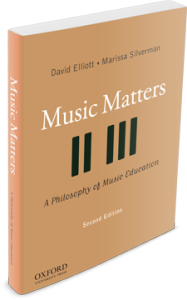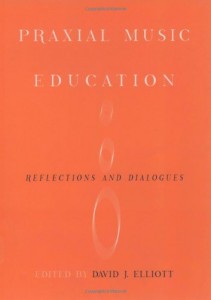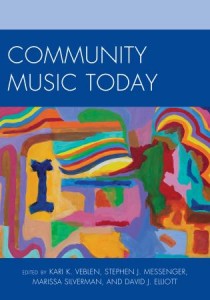Aims
Why teach music?
The praxial philosophy holds that music has many important values. Self-growth and self-knowledge — and the unique emotional experience of musical enjoyment that accompanies these — are among the most important values of music and music education.
These values are, therefore, the central aims of music education.
These values and aims are accessible, achievable and applicable to all students providing that we develop our students’ musicianship and listenership — their music making and listening abilities — progressively and in balanced relation to a variety of significant musical challenges over time.
To the extent that we enable our students to achieve these values, music education will also contribute to the development of students’ self-esteem and self-identity.
In addition to these values, musicing and listening extend the range of people’s expressive and impressive powers by providing us with opportunities to formulate musical expressions of emotions, musical representations of people, places and things and musical expressions of cultural-ideological meanings.
When this range of opportunities for musical expression and creativity is combined with the opportunities presented by texts in vocal and choral works, music makers gain numerous ways of giving artistic form to their powers of thinking, knowing, valuing, evaluating, believing and feeling which, in turn, challenge listeners’ conscious powers and musical understandings.
Based on the cognitive richness of musicing and listening, the praxial philosophy also argues that musical works play an important role in establishing, defining, delineating and preserving a sense of community and self-identity within social groups.
Also, teaching and learning a variety of Musics comprehensively as music-cultures (through a praxial approach) amounts to an important form of multicultural education. Why? Because entering into unfamiliar musical practices activates self-examination and the personal reconstruction of one’s relationships, assumptions and preferences. In the process of inducting learners into unfamiliar musical practices, music teachers link the basic values of music and music education to the broader goals of humanistic education.
Knowledge
What should music teachers teach? Asked another way: What knowledge is most worth learning by all music students?
My answer is: musicianship. Musicianship is the key to achieving the values and aims of music education.
Musicianship, which includes listenership, is a rich form of procedural knowledge that draws upon four other kinds of musical knowing in surrounding and supporting ways. Musicianship is context-sensitive, or situated: that is, the precise nature and content of musicianship and listenership differs from musical practice to practice (see Music Matters, Chps. 3 and 4).
Although verbal knowledge contributes importantly to the development of musicianship, verbal knowledge about music is secondary to procedural knowledge in music education. Howard Gardner (1990) supports this view when he argues that in a domain like music, verbal knowledge (or “talk” about music) is “an ancillary form of knowledge, not to be taken as a substitute for ‘thinking’ and ‘problem solving’ in the medium itself” (p. 42).
Learners
How should music education be carried out? 
Musicianship (which always includes listenership) is not something given “naturally” to some people and not to others. Musicianship is a form of cognition — a rich form of thinking and knowing — that is educable and applicable to all.
Accordingly, all music students ought to be taught in the same basic way: through performing, improvising, composing, arranging, conducting and, of course, listening to live and recorded music whenever possible. Listening ought to be taught and learned in direct relation to the music that students are learning to make and, also, in relation to recorded music presented in relation to and in the context of their active music making.
Howard Gardner (1991) agrees with this position:
. . . in the arts, production ought to lie at the center of any artistic experience. Understanding involves a mastery of the productive practices in a domain or discipline, coupled with the capacity to adopt different stances toward the work, among them the stances of audience member, critic, performer, and maker. (p. 239)
The differences between and among music education programs across grade levels, school regions (and so on) are not the contents of the music curriculum (musicianship and listenership) but, rather, the kinds and levels of musical challenges chosen for (and, perhaps, with the cooperation of) one’s students. In addition, music programs will differ in the kinds of music-making media (e.g., wind instruments, voices, string instruments, electronic instruments) chosen for (or with) one’s students.
Teaching-Learning Processes
How, more specifically, should music education be carried out?
Music education is not only concerned with developing musicianship and musical creativity in the present. An essential part of our task is to teach students how to continue developing their musicianship in the future. The praxial philosophy holds that the process of developing musicianship is a particular kind of learning process that students can engage in and learn how to employ themselves. I argue that the growth of musical understanding depends on progressive musical problem solving, problem finding and musical problem reduction . These processes require that students learn how to target their attention on more and more subtle aspects of the musical challenges they are attempting to meet. Achieving musicianship also involves learning to reflect critically on the creative promise of the musical ideas (interpretations, improvisations and so on) one generates and selects.
Implicit in all these processes is the broader requirement that all music students be engaged in rich and challenging music-making projects in classroom situations that are deliberately organized as close approximations of real musical practices.
Harvard psychologist Howard Gardner (1990) reinforces these principles from a developmental perspective:
students learn effectively when they are engaged by rich and meaningful projects; when their artistic learning is anchored in artistic production; when there is an easy commerce among the various forms of knowing . . .; and when students have ample opportunity to reflect on their progress. (p. 49)
Teachers
How . . . should music education be carried out?
Music education should be carried out by teachers who are musically competent themselves. Musicianship and teaching ability (or educatorship) are interdependent. One without the other is insufficient. To teach music effectively, we must know our subject: music. We must embody and exemplify musicianship. This is how children develop musicianship themselves: through actions, transactions and interactions with musically proficient teachers.
Becoming an excellent music teacher depends heavily on learning to reflect in and on one’s efforts to bring the musicianship of one’s students into matching relationship with appropriate musical challenges. For this to occur, novice music teachers require music education professors who can model musicianship and educatorship through their own vivid examples. Teacher education programs ought to be deliberately organized to prepare future artist-teachers through excellent models of teaching and excellent examples of diverse musical materials.
Evaluation
How . . . should music education be carried out?
There is an important distinction between evaluation and assessment. The primary function of assessment in music education is to provide feedback to students about the quality of their growing musicianship. Learners need constructive feedback about why, when and how they are meeting musical challenges (or not) in relation to musical standards and traditions. Overall, then, the assessment of student achievement gathers information that benefits students directly in the form of constructive feedback.
Assessment also provides useful data to teachers, parents and the surrounding educational community. Building on the accumulated results of continuous assessments, evaluation is primarily concerned with grading, ranking and other summary procedures for purposes of student promotion and curriculum evaluation.
Students also need to learn how to assess their own musical thinking by learning what counts as good music making and listening in a given musical style. To become independent judges of musical excellence in the future, students need regular opportunities to reflect on the results of their musicianship and that of their peers. It follows from this that assessment is the joint responsibility of teachers and students.
Because musicianship differs substantially from the kinds of verbal knowledge taught in scholastic settings, there is no justification for using standardized tests in music. There is justification for (a moderate number of) paper and pencil tests and written assignments about the verbal knowledge components of musicianship (music theory and music history). But overall, conventional methods of evaluation are inappropriate in music education because they rely too heavily upon linguistic thinking.
Teaching-Learning Context
How . . . should music education be carried out?
The praxial philosophy says: focus on achieving self-growth and musical enjoyment in the thoughtful actions of music making and listening. Teachers and students should work together to meet the musical challenges involved in realistic musical projects through reflective music making.
Each musical work that students are learning to interpret and perform (improvise, compose, arrange and so on) should be approached fully — as a “full course meal” — as a multidimensional challenge to be made artistically and listened-for intelligently in all its relevant dimensions (interpretive, structural, expressional and so on).
In support of artistic listening-in-context, carefully selected recordings ought to be introduced parenthetically: in direct relation to the musical practices students are being inducted into. Similarly, verbal musical knowledge should be filtered into the continuous stream of music making and listening as needed.
The praxial music curriculum is deliberately organized to engage learners in musical actions, transactions and interactions with close approximations of real music-cultures. The praxial curriculum immerses students in music-making projects which require them to draw upon the musical standards, traditions,lore, landmark achievements, “languages” and creative strategies of the musical practices of which their projects are a part.
From this perspective, the music teaching-learning environment is, itself, a key element in the music education enterprise. The musical actions of learners are enabled and promoted by the interactive, goal-directed “swirl” of questions, issues and knowings that develop around students’ efforts as reflective musical practitioners. The praxial curriculum is, itself, informative.
In sum, when small and large performing ensembles (e.g., a class choir, guitar ensemble, African drumming ensemble, string ensemble, jazz ensemble, wind ensemble and so on) are developed and carried out in relation to the above principles, and when performing is supplemented with improvising, composing, arranging, conducting and music-listening projects, then the music classroom becomes a reflective musical practicum: an approximation of real music-practice situations, or music-cultures. The music-practicum context feeds back to students by revealing “what counts” in their developing musicianship.



